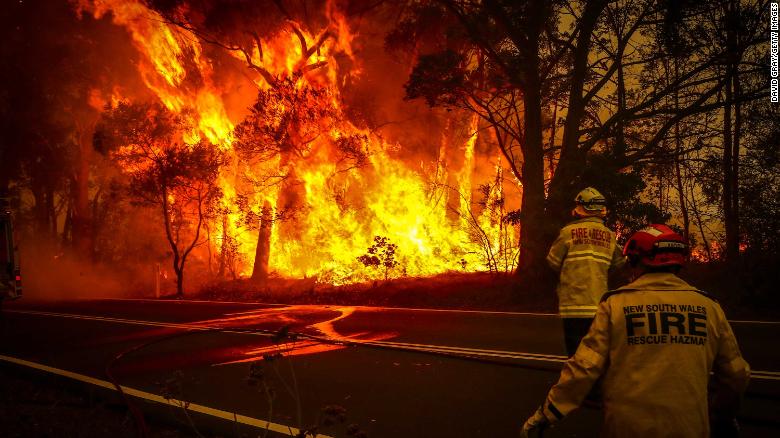What you need to know about Australia’s deadly wildfires

Across Australia more than a dozen people have died, and in the state of New South Wales alone, more than 900 houses have been destroyed. State and federal authorities are struggling to contain the massive blazes, even with firefighting assistance from other countries, including the United States.All this has been exacerbated by persistent heat and drought, and many point to climate change as a factor making natural disasters go from bad to worse.Where are the fires?There have been fires in every Australian state, but New South Wales has been hardest hit.Blazes have torn through bushland, wooded areas, and national parks like the Blue Mountains. Some of Australia’s largest cities have also been affected, including Melbourne and Sydney — where fires have damaged homes in the outer suburbs and thick plumes of smoke have blanketed the urban center. Earlier in December, the smoke was so bad in Sydney that air quality measured 11 times the “hazardous” level.The fires range in area from small blazes — isolated buildings or part of a neighborhood — to massive infernos that occupy entire hectares of land. Some start and are contained in a matter of days, but the biggest blazes have been burning for months.What is causing the fires?Each year there is a fire season during the Australian summer, with hot, dry weather making it easy for blazes to start and spread.Natural causes are to blame most of the time, like lightning strikes in drought-affected forests. Dry lightning was responsible for starting a number of fires in Victoria’s East Gippsland region on Sunday, which then traveled more than 20 kilometers (12.4 miles) in just five hours, according to state agency Victoria Emergency.Other places like California and Indonesia also have regular fire seasons — but Australian bushfires are unique because they often carry embers on the wind and start fresh blazes far away from the original fire front.Humans can also be to blame. In November, the NSW Rural Fire Service arrested a 19-year-old volunteer member on suspicion of arson, charging him with seven counts of deliberately setting fires over a six-week period.Why are the fires so bad?Fire season in Australia is always dangerous — the 2009 Black Saturday fires killed 173 people in Victoria, making it the deadliest bushfire disaster on record. But conditions have been unusually severe this year, fanning the flames and making firefighting conditions particularly difficult. Australia is experiencing one of its worst droughts in decades — the country’s Bureau of Meteorology said in December that last spring was the driest on record. Meanwhile, a heatwave in December broke the record for highest nationwide average temperature, with some places sweltering under temperatures well above 40 degrees Celsius (about 113-120 degrees Fahrenheit). Strong winds have also made the fires and smoke spread more rapidly, and have led to fatalities — a 28-year-old volunteer firefighter died in NSW on Monday after his truck rolled over in high winds.Experts say climate change has worsened the scope and impact of natural disasters like fires and floods — weather conditions are growing more extreme, and for years, the fires have been starting earlier in the season and spreading with greater intensity. Several high-ranking emergency service officials, including the former commissioner of the NSW Fire and Rescue Department, sent letters to Prime Minister Scott Morrison in 2019 warning of the impact of the climate crisis on Australia.What has been the damage so far?Entire towns have been engulfed in flames, and residents across several states have lost their homes. The heaviest structural damage occurred in NSW, the country’s most populated state, where more than 900 homes have been destroyed and over 350 damaged. The fires have burned 3.6 million hectares of land in NSW, 1.2 million hectares in Western Australia, at least 250,000 hectares in Queensland, and more than 91,000 hectares in South Australia, according to the states’ fire authorities. In total, more than 5.1 million hectares have been burned — an area the size of Costa Rica.To put it into perspective, California’s deadliest-ever fire burned about 62,053 hectares, and this year’s Amazon rainforest fires burned under a million hectares.More than a dozen people have died this fire season, including several volunteer firefightersThere has also been extensive damage to wildlife and ecology. Almost a third of koalas in NSW may have been killed in the fires, and a third of their habitat has been destroyed, said Federal Environment Minister Sussan Ley.What is being done?State and federal authorities have been working to combat the fire crisis for months.NSW declared a state of emergency in December, which grants “extraordinary powers” to the NSWRFS commissioner, including the authority to allocate government resources and direct government agencies in taking action. The state of Queensland also briefly declared a state of emergency in November.There are 2,000 firefighters working on the ground in NSW alone, and more support is on the way — the US, Canada, and New Zealand have sent additional firefighters to help. The federal government has also sent in military assistance like army personnel, air force aircraft, and navy cruisers for firefighting, search and rescue, and clean-up efforts.Morrison said his administration was allocating at least 23 million Australian dollars ($16.2 million) in disaster recovery payments to affected families and businesses, and up to 6,000 Australian dollars ($4,200) each for volunteer firefighters called out to fight fires for more than 10 days. When will the fires end?Unfortunately, Australia is only just entering its summer season. Normally, temperatures peak in January and February, meaning the country could be months away from finding relief.The fires are unlikely to end entirely since they are an annually occurring event — and may even get worse if recent years are a guide.





